Chinese Journal of Tissue Engineering Research ›› 2024, Vol. 28 ›› Issue (1): 20-25.doi: 10.12307/2023.917
Previous Articles Next Articles
Mechanism underlying exosomal lncRNA H19 derived from umbilical cord mesenchymal stem cells promotes cartilage injury repair
Wang Xianfeng1, Wang Kun2, Sun Han2, Sun Xiaoliang2, Yan Litao2
- 1Department of Sports Medicine, Beijing Jishuitan Hospital Guizhou Hospital, Guiyang 550000, Guizhou Province, China; 2Department of Articular Orthopedics, Third Affiliated Hospital of Soochow University, Changzhou 213000, Jiangsu Province, China
-
Received:2022-10-24Accepted:2023-01-29Online:2024-01-08Published:2023-06-28 -
Contact:Yan Litao, PhD, Physician, Department of Articular Orthopedics, Third Affiliated Hospital of Soochow University, Changzhou 213000, Jiangsu Province, China -
About author:Wang Xianfeng, Master, Attending physician, Department of Sports Medicine, Beijing Jishuitan Hospital Guizhou Hospital, Guiyang 550000, Guizhou Province, China -
Supported by:Youth Program of National Natural Science Foundation of China, No. 82202679 (to YLT); General Project of Natural Science Research in Colleges and Universities in Jiangsu Province, No. 22KJB320008 (to YLT); Changzhou Applied Basic Research Program, No. CJ20220109 (to YLT); Changzhou Applied Basic Research Program, No. CJ20220070 (to WK); Changzhou Applied Basic Research Program, No. CJ20220103 (to SH)
CLC Number:
Cite this article
Wang Xianfeng, Wang Kun, Sun Han, Sun Xiaoliang, Yan Litao. Mechanism underlying exosomal lncRNA H19 derived from umbilical cord mesenchymal stem cells promotes cartilage injury repair[J]. Chinese Journal of Tissue Engineering Research, 2024, 28(1): 20-25.
share this article
Add to citation manager EndNote|Reference Manager|ProCite|BibTeX|RefWorks
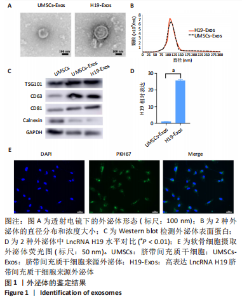
2.1 UMSCs外泌体的提取和鉴定 通过慢病毒转染建立了高表达LncRNA H19的UMSCs系(H19-UMSCs),与未转染UMSCs在相同条件下培养并留取培养上清,通过超速离心法成功提取其中的外泌体(UMSCs-Exos和H19-Exos)。2种外泌体在透射电镜下均呈现出典型的一侧凹陷半球形,见图1A。通过Zetaview仪器分析得出2种外泌体直径约130 nm,见图1B。Western blot检测2种外泌体表达特征蛋白CD63、CD81和TSG1010,不表达Calnexin,见图1C。PCR结果证明H19-Exos中的LncRNA H19水平远远超过对照组,见图1D,这表明UMSCs中高表达的LncRNA H19可以在外泌体中富集并被分泌。通过PKH67绿色荧光染料标记外泌体后与软骨细胞共培养,可以观察到软骨细胞中出现绿色荧光,这表明软骨细胞可以成功摄取2种外泌体,见图1E。上述结果表明H19-Exos拥有和普通Exos一样的典型外泌体特征,并且其中携带丰富的LncRNA H19分子,可被软骨细胞摄取。"
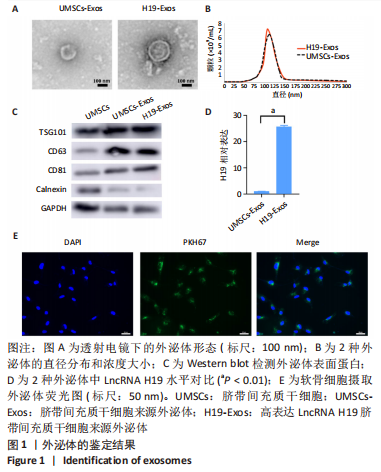
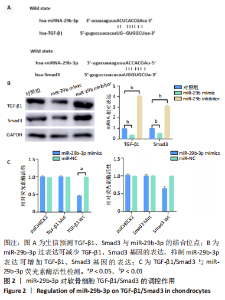
2.2 miR-29b-3p对软骨细胞TGF-β1/Smad3的调控作用 在课题组前期发表的成果中,已经证明了外泌体LncRNA H19可以通过吸附miR-29b-3p对软骨细胞的下游通路产生作用,因此该研究的重点为验证miR-29b-3p是通过靶向TGF-β1/Smad3通路发挥下游作用。首先通过生物学信息软件预测发现TGF-β1的编码区有miR-29b-3p的结合位点,并且TGF-β1的下游信号通路基因Smad3的3’UTR区域也有miR-29b-3p的结合位点,见图2A;通过Western blot检测到在软骨细胞中过表达miR-29b-3p可以同时下调TGF-β1、Smad3的mRNA和蛋白水平,而沉默 miR-29b-3p后,TGF-β1、Smad3的mRNA和蛋白水平上调,见图2B;双荧光素酶报告基因系统检测发现miR-29b-3p对下游靶基因TGF-β1和Smad3活性影响有显著差异,见图2C。上述结果表明软骨细胞中miR-29b-3p可以靶向抑制TGF-β1/Smad3通路的表达。"
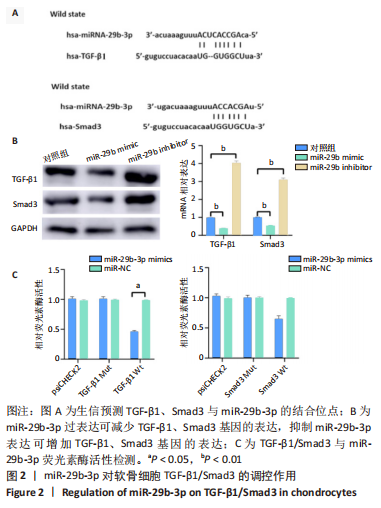
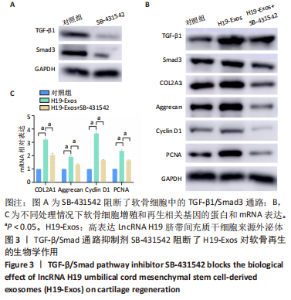
2.3 TGF-β1/Smad3通路抑制剂阻断了H19-Exos对软骨再生的生物学作用 通过特异性的小分子抑制剂SB-431542阻断软骨细胞的TGF-β1/Smad3通路,Western blot检测证明了该抑制剂的作用,见图3A。通过Western blot和PCR检测了与软骨增殖和再生的相关基因,发现H19-Exos组与其他组有显著差异,见图3B,C,表明高表达H19的外泌体对软骨细胞有显著的生物学作用,H19-Exos+抑制剂组与H19-Exos组比较差异有显著性意义。上述结果表明TGF-β1/Smad3通路被阻断后,H19在软骨细胞中的下游通路被阻断,影响了其促进软骨再生的作用,反向验证了H19-Exos是通过TGF-β1/Smad3通路促进软骨细胞的增殖和再生。"
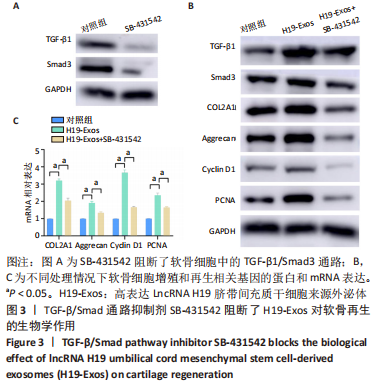
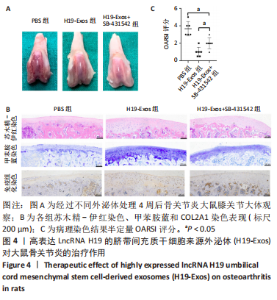
2.4 H19-Exos对大鼠骨关节炎的治疗作用 如图4A所示,大体观察发现骨关节炎造模组在4周后发生明显的骨关节炎样表现,以软骨剥脱、色泽变暗以及软骨下骨暴露为主要特征;H19-Exos组的大体表现接近正常软骨,仅有小部分软骨损伤;H19-Exos+抑制剂SB-431542组的严重程度介于前两组之间,主要变现为软骨菲薄,部分关节面损伤。如图4B所示,苏木精-伊红染色可见骨关节炎组软骨细胞排列紊乱,主要为纤维组织;H19-Exos组软骨细胞排列整齐均匀;H19-Exos+SB-431542组细胞排列较H19-Exos组紊乱,且细胞数量较少。甲苯胺蓝和COL2A1染色可见H19-Exos组软骨细胞中多糖物质和Ⅱ型胶原含量最高,H19-Exos+SB-431542组软骨细胞中多糖物质和Ⅱ型胶原含量高于骨关节炎组,表明SB-431542部分阻断了H19-Exos对软骨损伤修复的作用。用OARSI评分将上述病理染色结果作半定量分析发现H19-Exos组的骨关节炎表现最轻,与组织学染色结果一致,见图4C。"

| [1] VINA ER, KWOH CK. Epidemiology of osteoarthritis: literature update. Curr Opin Rheumatol. 2018;30(2):160-167. [2] LOESER RF, GOLDRING SR, SCANZELLO CR, et al. Osteoarthritis: a disease of the joint as an organ. Arthritis Rheum. 2012;64(6):1697-1707. [3] GAO SG, LI KH, ZENG KB, et al. Elevated osteopontin level of synovial fluid and articular cartilage is associated with disease severity in knee osteoarthritis patients. Osteoarthritis Cartilage. 2010;18(1):82-87. [4] MELDOLESI J. Exosomes and Ectosomes in Intercellular Communication. Curr Biol. 2018;28(8):R435-R444. [5] 王新伟,赵英杰,常艳,等.间充质干细胞治疗骨关节炎软骨损伤:作用、应用与问题[J].中国组织工程研究,2021,25(31):5053-5058. [6] 王宪峰,欧昕,邓必勇.不同来源间充质干细胞外泌体治疗骨关节炎疗效的比较[J].中国组织工程研究,2022,26(25):3980-3985. [7] YAN L, WU X. Exosomes produced from 3D cultures of umbilical cord mesenchymal stem cells in a hollow-fiber bioreactor show improved osteochondral regeneration activity. Cell Biol Toxicol. 2020;36(2):165-178. [8] YAN L, LIU G, WU X. Exosomes derived from umbilical cord mesenchymal stem cells in mechanical environment show improved osteochondral activity via upregulation of LncRNA H19. J Orthop Translat. 2021;26:111. [9] WU F, AN Y, ZHOU L, et al. Whole-transcriptome sequencing and ceRNA interaction network of temporomandibular joint osteoarthritis. Front Genet. 2022;13:962574. [10] CHEN H, CHEN L. An integrated analysis of the competing endogenous RNA network and co-expression network revealed seven hub long non-coding RNAs in osteoarthritis. Bone Joint Res. 2020;9(3):90-98. [11] YAN L, LIU G, WU X. The umbilical cord mesenchymal stem cell-derived exosomal lncRNA H19 improves osteochondral activity through miR-29b-3p/FoxO3 axis. Clin Transl Med. 2021;11(1):e255. [12] LIU YL, YANG WH, CHEN BY, et al. miR‑29b suppresses proliferation and induces apoptosis of hepatocellular carcinoma ascites H22 cells via regulating TGF‑β1 and p53 signaling pathway. Int J Mol Med. 2021;48(2):157. [13] GUO J, LIN Q, SHAO Y, et al. miR-29b promotes skin wound healing and reduces excessive scar formation by inhibition of the TGF-β1/Smad/CTGF signaling pathway. Can J Physiol Pharmacol. 2017;95(4):437-442. [14] PRITZKER KP, GAY S, JIMENEZ SA, et al. Osteoarthritis cartilage histopathology: grading and staging. Osteoarthritis Cartilage. 2006;14(1):13-29. [15] SACITHARAN PK. Ageing and Osteoarthritis. Subcell Biochem. 2019;91:123-159. [16] FUJII Y, LIU L, YAGASAKI L, et al. Cartilage Homeostasis and Osteoarthritis. Int J Mol Sci. 2022;23(11):6316. [17] 王琦,易诚青.膝关节骨关节炎治疗的研究进展[J].复旦学报(医学版),2022, 49(5):765-770. [18] HUSSAIN SM, NEILLY DW, BALIGA S, et al. Knee osteoarthritis: a review of management options. Scott Med J. 2016;61(1):7-16. [19] KAN HS, CHAN PK, CHIU KY, et al. Non-surgical treatment of knee osteoarthritis. Hong Kong Med J. 2019;25(2):127-133. [20] MAKRIS EA, GOMOLL AH, MALIZOS KN, et al. Repair and tissue engineering techniques for articular cartilage. Nat Rev Rheumatol. 2015;11(1):21-34. [21] LEE KB, HUI JH, SONG IC, et al. Injectable mesenchymal stem cell therapy for large cartilage defects--a porcine model. Stem Cells. 2007;25(11):2964-2971. [22] NEJADNIK H, HUI JH, FENG CHOONG EP, et al. Autologous bone marrow-derived mesenchymal stem cells versus autologous chondrocyte implantation: an observational cohort study. Am J Sports Med. 2010;38(6):1110-1116. [23] BACAKOVA L, ZARUBOVA J, TRAVNICKOVA M, et al. Stem cells: their source, potency and use in regenerative therapies with focus on adipose-derived stem cells - a review. Biotechnol Adv. 2018;36(4):1111-1126. [24] ZHANG S, CHU WC, LAI RC, et al. Exosomes derived from human embryonic mesenchymal stem cells promote osteochondral regeneration. Osteoarthritis Cartilage. 2016;24(12):2135-2140. [25] 凌华军,王其友,林伟文,等.骨髓间充质干细胞来源外泌体保护软骨细胞延缓骨关节炎的发生发展[J].中国组织工程研究,2021,25(31):4964-4969. [26] ZHANG Y, BI J, HUANG J, et al. Exosome: A Review of Its Classification, Isolation Techniques, Storage, Diagnostic and Targeted Therapy Applications. Int J Nanomedicine. 2020;15:6917-6934. [27] BATRAKOVA EV, KIM MS. Using exosomes, naturally-equipped nanocarriers, for drug delivery. J Control Release. 2015;219:396-405. [28] DUDEK KA, LAFONT JE, MARTINEZ-SANCHEZ A, et al. Type II collagen expression is regulated by tissue-specific miR-675 in human articular chondrocytes. J Biol Chem. 2010;285(32):24381-24387. [29] WANG CL, ZUO B, LI D, et al. The long noncoding RNA H19 attenuates force-driven cartilage degeneration via miR-483-5p/Dusp5. Biochem Biophys Res Commun. 2020;529(2):210-217. [30] NING B, JIN R, WANG D, et al. The H19/let-7 feedback loop contributes to developmental dysplasia and dislocation of the hip. Physiol Res. 2019;68(2):275-284. [31] 王伟康,刘晓冬,周长林,等.MiRNAs在骨关节炎发生发展中的调控作用[J].中国组织工程研究,2021,25(35):5709-5715. [32] CHEN L, LI Q, WANG J, et al. MiR-29b-3p promotes chondrocyte apoptosis and facilitates the occurrence and development of osteoarthritis by targeting PGRN. J Cell Mol Med. 2017;21(12):3347-3359. [33] LV M, ZHONG Z, HUANG M, et al. lncRNA H19 regulates epithelial-mesenchymal transition and metastasis of bladder cancer by miR-29b-3p as competing endogenous RNA. Biochim Biophys Acta Mol Cell Res. 2017;1864(10):1887-1899. [34] DING D, LI C, ZHAO T, et al. LncRNA H19/miR-29b-3p/PGRN Axis Promoted Epithelial-Mesenchymal Transition of Colorectal Cancer Cells by Acting on Wnt Signaling. Mol Cells. 2018;41(5):423-435. [35] TIAN X, ZUO X, HOU M, et al. LncRNA-H19 regulates chemoresistance to carboplatin in epithelial ovarian cancer through microRNA-29b-3p and STAT3. J Cancer. 2021;12(19):5712-5722. [36] CAO B, DAI X. Platelet lysate induces chondrogenic differentiation of umbilical cord-derived mesenchymal stem cells by regulating the lncRNA H19/miR-29b-3p/SOX9 axis. FEBS Open Bio. 2020;10(12):2656-2665. |
| [1] | Wei Yurou, Tian Jiaqing, He Xianshun, Zhan Zhiwei, Wei Tengfei, Lin Tianye, He Wei, Wei Qiushi. Effect of lentiviral silencing of Piezo1 on osteogenic differentiation and TAZ expression in human bone marrow mesenchymal stem cells [J]. Chinese Journal of Tissue Engineering Research, 2024, 28(1): 12-19. |
| [2] | Zhang Yuanshu, He Xu, Xue Yuan, Jin Yesheng, Wang Kai, Shi Qin, Rui Yongjun. Irisin alleviates palmitic acid-induced osteogenic inhibition in bone marrow mesenchymal stem cells [J]. Chinese Journal of Tissue Engineering Research, 2024, 28(1): 26-31. |
| [3] | He Lijun, Qi Xiaojuan. Adipose-derived mesenchymal stem cells overexpressing bone morphogenetic protein 2 promote alveolar bone defect repair in osteoporosis rats [J]. Chinese Journal of Tissue Engineering Research, 2024, 28(1): 32-37. |
| [4] | Zhou Minghua, Hu Xiaoyu. LncRNA SNHG4 regulates miR-152-3p during osteoblastic differentiation of periodontal ligament stem cells [J]. Chinese Journal of Tissue Engineering Research, 2024, 28(1): 38-43. |
| [5] | Zheng Rongjiong, Deng Zerun, Han Dan, Sun Lihua. Mechanism underlying rat hepatocyte apoptosis regulated by exosomes derived from bone marrow mesenchymal stem cells [J]. Chinese Journal of Tissue Engineering Research, 2024, 28(1): 44-49. |
| [6] | Zheng Mingkui, Xue Chenhui, Guan Xiaoming, Ma Xun. Human umbilical cord mesenchymal stem cell-derived exosomes reduce the permeability of blood-spinal cord barrier after spinal cord injury [J]. Chinese Journal of Tissue Engineering Research, 2024, 28(1): 50-55. |
| [7] | Sun Jing, Liao Jian, Sun Jiangling, Cheng Ping, Feng Hongchao. Recombinant human growth hormone promotes osteogenic differentiation of human dental pulp stem cells [J]. Chinese Journal of Tissue Engineering Research, 2024, 28(1): 56-61. |
| [8] | Chen Guanting, Zhang Linqi, Li Qingru. Research hot spots and trends of exosomes in theranostic application for chronic kidney disease [J]. Chinese Journal of Tissue Engineering Research, 2024, 28(1): 86-92. |
| [9] | Fan Yongjing, Wang Shu, Jin Wulong. Characteristics, advantages and application of osteogenic differentiation of jaw bone marrow mesenchymal stem cells [J]. Chinese Journal of Tissue Engineering Research, 2024, 28(1): 100-106. |
| [10] | Huang Yongbin, Wang Tao, Lou Yuanyi, Pang Jingqun, Chen Guanghua. Application prospect of mesenchymal stem cells in promoting muscle tissue repair [J]. Chinese Journal of Tissue Engineering Research, 2024, 28(1): 107-112. |
| [11] | Shen Feiyan, Yao Jixiang, Su Shanshan, Zhao Zhongmin, Tang Weidong. Knockdown of circRNA WD repeat containing protein 1 inhibits proliferation and induces apoptosis of chondrocytes in knee osteoarthritis [J]. Chinese Journal of Tissue Engineering Research, 2023, 27(在线): 1-6. |
| [12] | He Wanyu, Cheng Leping. Strategies and advance on stem cell transplantation for repair of spinal cord injury [J]. Chinese Journal of Tissue Engineering Research, 2023, 27(在线): 1-7. |
| [13] | Nong Fuxiang, Jiang Zhixiong, Li Yinghao, Xu Wencong, Shi Zhilan, Luo Hui, Zhang Qinglang, Zhong Shuang, Tang Meiwen. Bone cement augmented proximal femoral nail antirotation for type A3.3 intertrochanteric femoral fracturalysis [J]. Chinese Journal of Tissue Engineering Research, 2023, 27(在线): 1-10. |
| [14] | Li Xiaomin, Tian Xiangdong, Tan Yetong, Zhu Guangyu, Wang Rongtian, Wang Jian, Xue Zhipeng, Ma Sheng, Hu Yuanyi, Huang Ye, Ding Tiansong. Changes of lower limb force line and knee function after high tibial osteotomy in osteoporotic medial ventricular knee osteoarthritis [J]. Chinese Journal of Tissue Engineering Research, 2023, 27(9): 1325-1329. |
| [15] | Pan Zhongjie, Qin Zhihong, Zheng Tiejun, Ding Xiaofei, Liao Shijie. Targeting of non-coding RNAs in the pathogenesis of the osteonecrosis of the femoral head [J]. Chinese Journal of Tissue Engineering Research, 2023, 27(9): 1441-1447. |
| Viewed | ||||||
|
Full text |
|
|||||
|
Abstract |
|
|||||